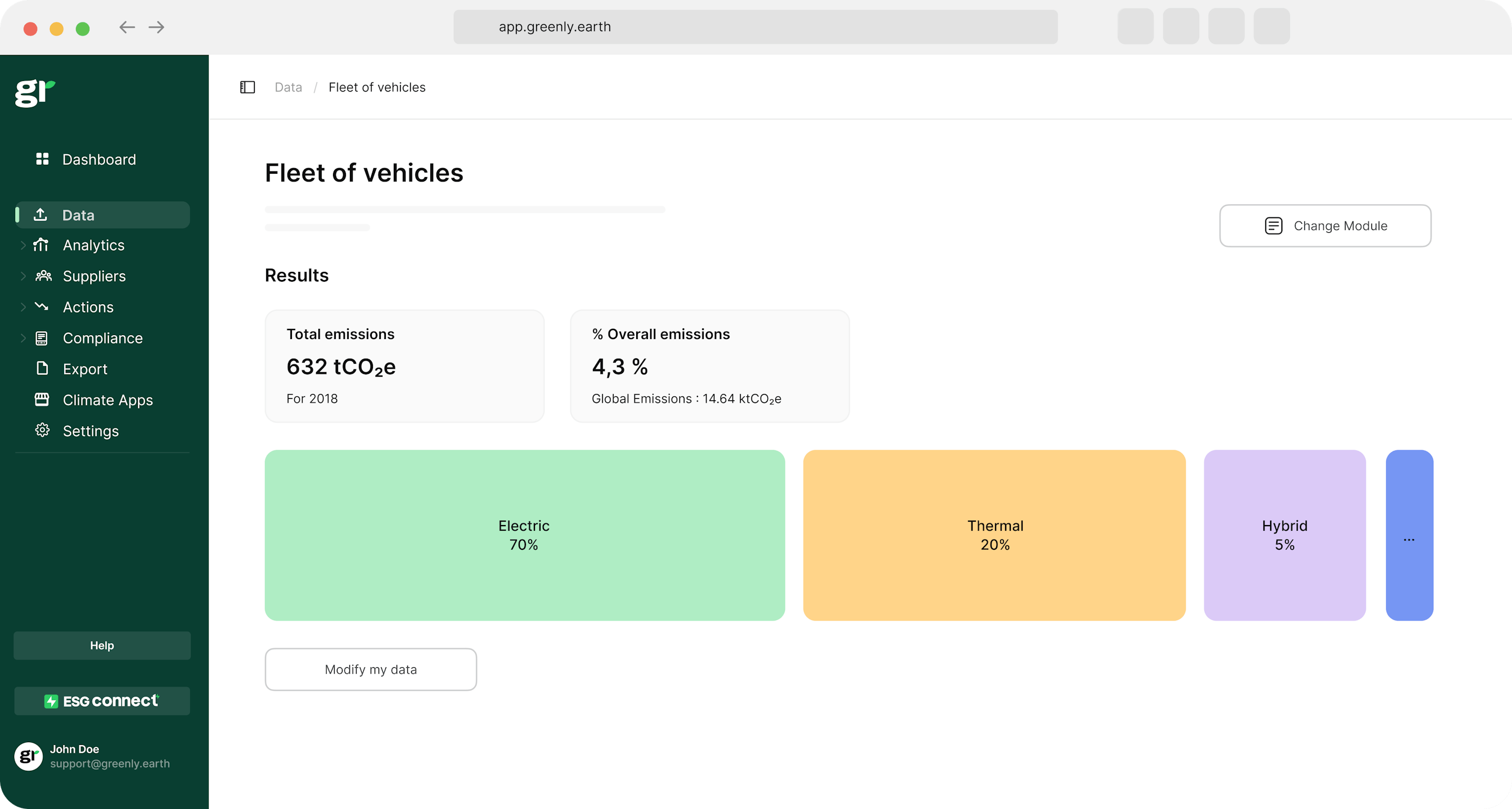
What are the 3 Pillars of Corporate Sustainability?
In this article, we'll explore what the 3 pillars of corporate responsibility are, why they're important, and how businesses can turn them into practical action.
ESG / CSR
Industries



Carbon accounting can already feel pretty daunting - and when you throw in terminology like spend-based method and activity-based method, it’s easy to feel overwhelmed. But not to worry because Greenly has your back. In this article, we’ll outline the two different methods of carbon accounting and look at the advantages and disadvantages of both methods.
What carbon accounting is and why it matters
The key differences between the spend-based and activity-based methods
The pros and cons of each carbon accounting methodology
Greenly’s methodology and how we ensure accurate, reliable results
Before we dive into the details on the spend-based method and activity-based method, let's have a quick reminder of what carbon accounting actually is and why it's important.


Carbon accounting (also referred to as greenhouse gas accounting) is a methodology that is used to measure and track an organization's greenhouse gas emissions. Just like financial accounting, it quantifies the impact of a company’s business activities, though instead of calculating the financial position, carbon accounting calculates the emissions impact.
Sometimes, a company might engage with carbon accounting because it's required for regulatory or legal purposes - an increasing number of companies are required to disclose emissions information. But it can also be used as a starting point for any company wishing to reduce its environmental impact.
Accurate emissions measurement
Carbon accounting quantifies greenhouse gas emissions across all scopes, creating a reliable baseline for action.
Regulatory compliance
Stay aligned with evolving disclosure rules by producing consistent, auditable emissions data.
Data-driven decisions
Measurement reveals hot spots so you can prioritize reductions and allocate resources effectively.
Transparency & credibility
Traceable records build trust with customers, investors, and teams through clear reporting.
Supports targets
Provides the basis to set science-aligned goals and track progress year over year.
Benchmarking & tracking
Repeat cycles allow comparison across periods, business units, and suppliers to drive improvement.
Carbon accounting also serves as a basis for carbon assessment. Carbon assessment is the act of evaluating the numerical data. It allows a company to understand the emissions that they’re producing and, therefore, what actions they can take to reduce their carbon footprint. After all, as the saying goes, “you can’t manage what you can’t measure”.
There are two methodologies used in carbon accounting. These are the spend-based method and the activity-based method. There is also a hybrid approach, which combines a mix of the two.
Read on to learn more about the different methodologies:
The spend-based method of carbon accounting takes the financial value of a purchased good or service and translates it into emissions with a corresponding spend-based emission factor.
According to Greenly's experts, "the spend-based emissions factor is a representative value that relates the quantity of an emission to a certain financial expenditure." Or in layman's terms, the spend-based method allows us to calculate the amount of emissions produced per financial unit of a certain activity.
When it comes to the spend-based approach, these flows can be divided into two categories:
Payments made by the company to its suppliers, its employees, the State (taxes), or to repay bank loans.
Payments made by customers who purchase the company’s goods or services.
Financial data actually reflects activity-based flows, since every action or delivery generates a payment (energy bills, travel costs, etc.).
The activity-based method is based on emissions activities performed by the company and involves the collection of the company’s raw data for these different emissions sources. The type of data collected by the company will vary depending on their specific activities, but typically includes things like energy consumption, fuel usage, production volumes, transport distances etc.
One of the main ways that the activity-based method is different from the spend-based method is in the collection of data.
The spend-based method collects financial data only, whereas the activity-based method of carbon accounting focuses on gathering specific and detailed data from across a company’s entire value chain.
These physical or real flows represent measurable data linked to a company’s operations. Depending on the data source, they can be expressed in different ways: for example, by mass (kilograms purchased or processed), distance (km travelled), or units (number of products sold).
It's also worth noting that physical flows can be both:
For example, a truck transporting semi-finished products from site A to site B — both owned by the company.
These include incoming goods (raw materials and supplies needed for production or operations), incoming services, outward flows of goods (sales of finished products), or the provision of services.
Once the various activity-based data sources have been collected, this information is then used to calculate the emissions from each activity by applying the corresponding emission factors.
The activity emission factors represent an average greenhouse gas emission per unit of activity and offer a more accurate reflection of emissions associated with each activity.
Just like it says on the tin - the hybrid-based carbon accounting method is a hybrid of both the spend-based method and the activity-based method. Essentially, it's the practice of using all of the activity-based data available, and then supplementing any missing activity-based data by using the spend-based approach to calculate the rest.
This is, more or less, Greenly's carbon accounting method. In the next section, we'll explore the advantages of the different methods and why we believe the hybrid method is the best approach.
Easy to source
Uses readily available financial data, making initial measurement straightforward and low-friction.
Time-efficient
Faster to implement than activity-based approaches, enabling quick baselining and comparisons.
Scales to complexity
Works well when granular supplier data is hard to obtain across large, complex value chains.
Lower accuracy
Relies on industry averages that may not reflect a company’s specific suppliers, practices, or technologies.
Price variability
Financial values change with price inflation, discounts, or FX — which can distort emissions estimates.
Coverage gaps
Because it’s finance-based, some activities may be under-captured or missed within the chosen scope.
Higher accuracy
Relies on detailed, activity-level data, producing a more precise and reliable carbon footprint.
Comprehensive coverage
Captures a broader range of emission sources across direct and indirect activities, offering a full picture of impact.
Granular insights
Helps organizations pinpoint high-emission activities and identify precise areas for reduction.
Complex data collection
Gathering granular data from multiple sources can be time-consuming and resource intensive.
Supplier data gaps
Relies on information from third parties, which may be incomplete or unavailable for all activities.
Longer implementation
More time and coordination are needed to compile and validate the full set of activity data.

The hybrid approach combines the best of both worlds, blending the spend-based and activity-based methods to create a more balanced and complete view of a company’s emissions.
By using activity-based data wherever it’s available, carbon footprint calculations are more accurate. At the same time, the spend-based method helps fill in any gaps when detailed data isn’t available, making sure that no part of the value chain is left out.
That said, the hybrid method can be more complex to manage. Because it mixes financial and activity-based data, it often requires stronger coordination and data management to make sure everything aligns correctly.
There’s no getting around it; calculating your company’s carbon footprint can be complex. It means juggling multiple data sources, priorities, and methodologies to find the right approach. That’s where bringing in the experts makes all the difference.
At Greenly, our team is here to guide you every step of the way. From figuring out the best way to measure your emissions, to running the calculations, and finally helping you build a practical action plan to kick-start your journey towards net zero.
Greenly’s methodology is the best of both worlds and uses both the activity-based approach and the spend-based approach. We flex these two methodologies on a case-by-case basis to make sure that each client has a tailored approach that works for their specific scenario. By combining these two complementary methodologies, we’re able to ensure that your carbon footprint is as accurate and reliable as possible.
At Greenly, our carbon assessments combine both approaches - since relying on the monetary method alone doesn’t give a full or truly accurate picture of a company’s emissions.
That said, our experts don’t rule out the spend-based method. It’s extremely useful for understanding the impact of purchased goods and services, especially when gathering physical data isn't feasible.
Whenever possible, though, we prioritise the physical approach since using real data, linked to a specific process, activity, or product, helps paint a more accurate picture of a company’s actual impact.
Greenly typically starts with data collection using the monetary approach to identify the main sources of emissions.
The physical approach is then used to deepen the analysis and support the development of an action plan.
At Greenly, we can help you assess your company’s carbon footprint and then give you the tools you need to cut down on emissions. Why not request a free demo with one of our experts - no obligation or commitment required.
Here, we answer the most common questions on carbon accounting.
It’s the process of measuring and tracking an organization’s greenhouse gas emissions across activities and scopes.
Spend-based uses financial data with emissions factors per currency unit; activity-based uses physical data (kWh, litres, km, units) with factors per unit of activity.
Activity-based is generally more precise; spend-based is faster and broader. Many companies use a hybrid of both.
Using activity-based data wherever available, and spend-based to fill gaps - so coverage is complete without delaying the assessment.
They’re average values that convert an activity or spend into emissions. They’re updated as new data emerges and can be region- or technology-specific, so source selection matters.
From recognized databases and agencies (eg. national government conversion factors, EPA hubs, IPCC/EEA/IEA datasets), plus some country-specific sources.
Scopes define where a company’s emissions originate. They’re an essential part of carbon accounting because they determine which activities are included in the footprint, helping ensure the assessment covers the full value chain, not just on-site energy use.
Yes, Scope 3 emissions often represent the majority of a company’s total footprint. Leaving them out means the analysis won’t reflect the organization’s true climate impact.